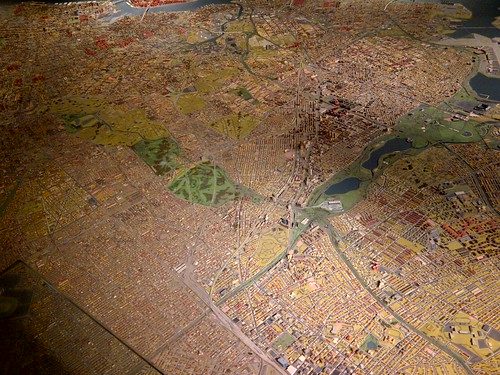A couple of weeks ago, meli emailed me about an exhibit about the Taíno at the National Museum of the American Indian (NMAI) in NYC. I checked the site for current and upcoming exhibits and couldn’t find it. Then last week she sent me an NMAI tweet about the same exhibit and I checked again and finally found it on their calendar. Turned out that Taíno Culture and Identity! is a special event only held on Mondays from 2-4pm. Since that’s an inconvenient time for a working person, the only time I could go would be a Monday holiday and luckily the next Monday was Martin Luther King Jr. Day.
Got there and the volunteer at the front desk told me that they don’t have the event on holidays because all the employees are off and the museum is staffed solely by volunteers. When I told her that I’d seen it on the calendar, she showed me the website and the event had disappeared. I asked if that meant it wouldn’t be happening on Presidents’ Day either and she said it would not. When I got home I looked up Monday, February 19th (Presidents’ Day) and there it was.
A letter and email has been written.
NMAI-NYC is in the Alexander Hamilton US Custom House, which is a beautiful old building. When it was a custom house the main room on the first floor was filled with desks and men hunched over each desk wearing green eyeshades and carefully writing in their ledgers the manifests of each ship coming into New York harbor.
Now that main hall is empty but you can look up and see the gorgeous skylight and see the paintings up near ceiling. And imagine the noise and activity that took place behind the low marble wall for so many years.
Three exhibits were open that day. The permanent exhibit is Infinity of Nations: Art and History in the Collections of the National Museum of the American Indian, which is Native American art from North, Central, and South America. Some of the pieces are really beautiful. I didn’t take photos of anything except for a few pieces. Both in this exhibit and the next, I was surprised to discover that jade was used in Mesoamerica since Olmec times and jadeite was used by the Mayans in what is now Guatemala. Maybe I’m the only one who didn’t know this – I always thought of jade and jadeite as Eastern minerals.
One of my favorite parts of the exhibit were the modern pieces. This is a jingle dress by Maria Hupfield (Anishinaabe, Wasauksing First Nation).
Cerámica de los Ancestros: Central America’s Past Revealed, NY was a bilingual exhibit of beautiful ceramic pieces and jewelry. The Mayan jadeite above was in this exhibit. Click on any of the exhibition links to see the catalogs and photos of many of the displayed pieces and installations.
Transformer: Native Art in Light and Sound was a modern celebration of the traditional. There was film of modern dance with traditional music. An installation of speakers covered in woven straw as if the fronts were baskets (Aosamia’jij – Too Much Too Little) was by Jordan Bennett (Mi’kmaq). Nature sounds and the sound of people weaving played through the speakers and on the opposite wall was a series of photos taken in 1931showing a Mi’kmaq man fishing. John Corbett’s (Métis) Four Generations was a video of four generations of his family where the faces changed from one into the other pixel by pixel.
Stephen Foster’s (Haida/European) Raven Brings the Light was a tent with shadow puppets telling a Pacific Northwest origin story. Julie Nagam’s (Anishnawbe/Métis/German/Syrian) Our Future is in the Land: If We Listen to It was a digital video on two walls of drawings of tall birches and the occasional small animal with sounds of nature surrounding you. We sat down and Peter was talking and I told him to be quiet and just listen. One minute later he said, “You know what I learned?” and I immediately responded, “That you can’t shut up?” which made him laugh and that made me laugh but we didn’t want to laugh out loud, which made us laugh more (all silently) and tears were rolling down our cheeks from laughing so hard and trying to be quiet at the same time.
Raven Chacon’s (Diné) Still Life, #3 was probably our favorite. On one end of the room was a series of speakers going up to the ceiling and then the line continued across the ceiling. A woman tells the Diné origin story and it passes from speaker to speaker as it would from generation to generation. Along the walls, written on glass, are excerpts from the story written in both English and Diné. The light in the room shifts through the four sacred colors – white (dawn) to blue (midday) to yellow (dusk) to black/red (night) and each color casts shadows of the words onto the wall.
By Carene Lydia Lopez















